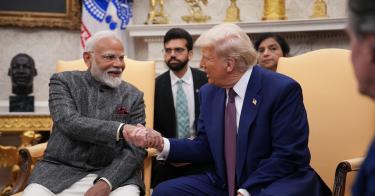In a departure from the U.S. policy of offering F-35 fifth generation fighter only to treaty allies, President Donald J. Trump offered the fighter jet to India during a joint press conference with Prime Minister Narendra Modi on February 13. With claims that China’s J-20 fighter aircraft is already deployed, and with Pakistan inducting advanced variants of the JF-17, India needs to step up its game. India’s domestic Advanced Medium Combat Aircraft (AMCA) program remains years away from operational readiness, while Russian alternatives like the Su-57 carry concerns about reliability. By contrast, the F-35 offers superior performance and integration into global defense networks. For New Delhi, the choice is no longer just technical; it is strategic and time-bound.
Why Does India Need a Fifth-Generation Aircraft?
A fifth-generation aircraft is increasingly both a strategic imperative and an operational necessity for New Delhi. China’s Chengdu J-20 Mighty Dragon, a fifth-generation stealth fighter, is now operational in the People’s Liberation Army Air Force (PLAAF). While assessments of its combat effectiveness vary, its very existence marks a shift in regional airpower dynamics. Meanwhile, Pakistan continues to co-develop the JF-17 fighter with China, including more advanced variants like the Block III.
Currently, India’s frontline aircraft are Russian-origin: Su-30MKIs, Mirage 2000s, and MiG-29s. All of these aircraft belong to the fourth or 4.5 generation. Further, the Indian Airforce is currently operating only 31 squadrons against a targeted end-strength of 42, a gap exacerbated by the gradual phasing out of its MiG-21 squadrons.
India’s first attempt at indigenously developing a fifth-generation fighter began with the FGFA project in the early 2000s. New Delhi committed around $6 billion in investment, expecting significant technology transfer and co-development through a joint venture between India’s HAL and Russia’s Sukhoi. However, the project did not see the light of the day due to rising costs, delays in Russia’s own Su-57 program, and technical shortcomings identified by the Indian Air Force, including limited stealth capabilities, poor sensor fusion, and unreliable engines. There were also concerns over Russia’s reluctance to share core technologies and its diverging design priorities. Ultimately, India exited the project in 2018.
Despite the failure of the FGFA joint venture with Russia, India did not abandon its fifth-generation ambitions. Instead, it pivoted to developing a domestic alternative—the AMCA. In 2023, the Indian government approved $1.8 billion for AMCA’s prototype development. Assuming timelines hold, the first flight is expected around 2026, with induction by 2032. However, the ambitious project is not without challenges. India lacks domestic capabilities in areas like stealth materials, advanced jet engines, integrated avionics, and more. No one would be surprised if the induction timeline is delayed.
The Options Before India
Beyond India’s own AMCA, the country has two options—the Russian Su-57 and the US F-35. The Su-57 comes with a reportedly cheaper price tag and the promise of transferring technology to India. However, the aircraft still lacks a proven operational history and is Russia’s first experiment with stealth technology. Its maintenance ecosystem is uncertain, and its support logistics could be hampered by international sanctions and geopolitical volatility. Further, India has previous rocky experience with Russian fifth generation aircraft, and it usually prefers to avoid inducting into service equipment and platforms without a proven battle history.
On the other hand, the F-35 is the most widely deployed fifth-generation fighter in the world. The platform is also combat-proven, backed by over 17 allied air forces, and supported by a global maintenance and supply network.
However, acquiring the F-35 is not straightforward.
Bridging the Trust Gap
The U.S. has its own concerns about selling India the F-35, including legitimate concerns about both technological and operational security. Platforms like the F-35 rely on secure datalinks and integrated battlefield networks where systems operate in a common environment and as a single unit. As a result, Washington has been hesitant to offer the F-35 to countries that operate Russian-origin equipment due to possible data security risks and concerns over technology leaks. For an F-35 deal to materialize, India would need to undertake credible reforms to safeguard sensitive U.S. defense technologies while also maintaining interoperability. This includes both addressing U.S. concerns around Russian systems like the S-400 and implementing robust measures to strengthen cybersecurity and research security.
While demanding, these reforms are not without precedent. Strategic partners like Australia and Japan have made similar adjustments as part of deeper defense cooperation with the US—enhancing their own defense ecosystems in the process. For India, these steps would not only unlock access to platforms like the F-35, but would also accelerate its transition to a modern, secure, and globally interoperable defense infrastructure.
From a U.S. strategic standpoint, facilitating India’s acquisition of the F-35 directly advances core American objectives in the Indo-Pacific. An Indian Air Force equipped with the world’s most advanced fifth-generation fighter could serve as a more powerful deterrent to Chinese military adventurism and bolster regional stability. It would also deepen defense interoperability with a critical partner, diversify F-35 operators beyond treaty allies, and create new momentum for joint operational planning and technology integration. At a time when great power competition is intensifying, the move would also send a strong signal by placing India in a select group of nations trusted with the most advanced U.S. defense technologies.
What Should India Do?
India’s goal must remain to develop its own fifth-generation aircraft while being realistic regarding AMCA development timelines, operational needs, and timely action. Thus, it must balance ambition (AMCA), opportunity (F-35), and realism (what is possible).
- Engage in Interim Acquisition of F-35s: A limited number of F-35As could serve as a stopgap solution, bridge the capability gap, meet immediate needs, and provide critical operational experience with fifth-generation systems.
- Accelerate AMCA Development: The Indian government must provide adequate funding, empower HAL and its partners with greater autonomy, and tap into the private sector and startups for innovation in materials, AI, and electronics to avoid unwarranted delays.
- Deepen U.S.-India R&D Collaboration: India should seek structured collaboration with the United States and like-minded partners on stealth coatings, electronic warfare systems, and MUM-T (manned-unmanned teaming). Programs like the India-U.S. Defense Acceleration Ecosystem (INDUS-X) could be used to co-develop or co-produce technologies relevant for AMCA and beyond.
- Create a Long-Term Technology Roadmap: Beyond AMCA, India should invest in sixth-generation technologies—like unmanned loyal wingmen, swarm drones, hypersonic delivery systems—and integrate them into its defense R&D strategy.
The Bigger Strategic Choice
A fifth-generation fighter is not merely a military asset; it signals intent. As India weighs its options, the choice is not just about capability but a commitment to modernization, trusted partners, and future combat readiness. The skies are shifting, and India must decide whether it intends to lead or lag in the battlespace of tomorrow.




